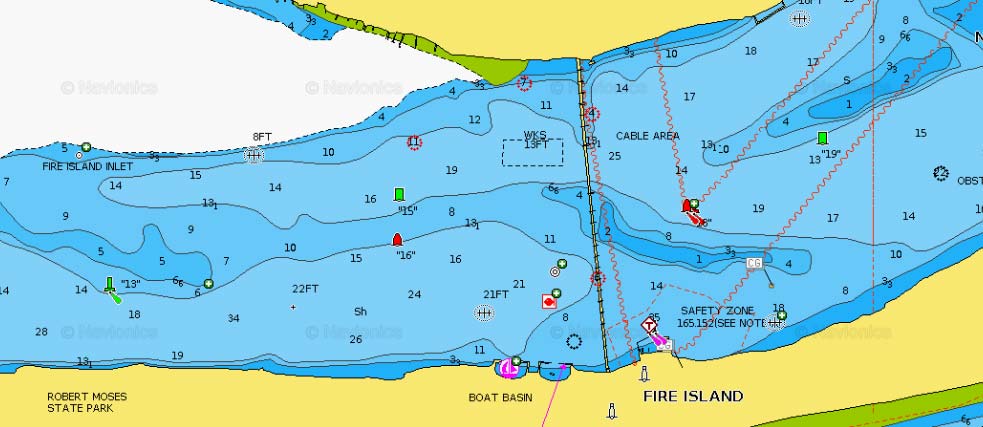
N 40°62’12” / W 73°26’36”
The Robert Moses Bridge is the last of three spans connecting the mainland to Fire Island, crossing over the easternmost expanse of Fire Island Inlet. From spring through fall, scores of private boat anglers, shorebound casters and most of the Captree fleet rely on this structure for its variety of angling opportunities, and for an unusually high level of consistency. Whether you’re hunting stripers, blues, weakfish, fluke or blackfish, the waters under and around the bridge can usually be counted on to produce some action.
The bridge and its supporting abutments are probably best known for their ability to produce stripers on a consistent basis from the opening gun in April until the season closes in December. Clam chumming is a popular approach that many private boatmen rely on, but many others have discovered that casting bucktails and soft plastics around the bridge’s shadow lines can be equally productive on night tides, and it’s a lot more fun. Most Captree open and charter boats that target stripers rely on this approach, especially in the spring, and again in the fall. Drifting live eels will account for their share of bigger stripers, but with the current 28 to 35-inch slot limit in effect, fewer anglers appear to be targeting the larger bass.
The bridge sits in the middle of the main thoroughfare for fish entering and leaving the confines of Great South Bay. This is especially true of fluke migrating in from the ocean in spring and summer, and then reversing their track in late summer and early fall. As a result, the rips adjacent to the bridge can be counted on to yield summer flatties from May through September. And while there will be a fair amount of “slow” days, there will also be days when you can’t keep the fluke off your baits. The final weeks of this season saw the area on the east side of the bridge produce the best fluke fishing of the entire season, with many keepers making up the action. Often, the best fluking takes place here on the last half of the incoming current and the beginning of the ebb. Some shallow bars make up adjacent to both sides of the bridge, particularly along the southeast quarter. Light spinning tackle and small bucktails or leadheads tipped with Berkley Gulp, FishBites or belly strips are a perfect fit for working these shallows.
Tons of rock dumped around the base of the abutments in recent years have made for some excellent blackfish habitat. Spring blackfishing is limited to April due to seasonal closures, but some decent scores are possible for those tipping jigs with fiddler or green crabs. The fall season is a better bet, and the recent upsurge in blackfish numbers has already produced some fine catches this season.
A nice feature for those who trailer their boat is that the Captree Launch Ramp, one of the best in the state, is right around the corner from the bridge. Launching at Captree eliminates what is often a bumpy and sometimes wet ride across the bay, and there are no residency restrictions.
The shoreline at both ends of the span is certainly worth the efforts of surfcasters probing for bass and blues. Both ends offer good potential for connecting with stripers, while bluefish seem more confined to the northern shore, where many casters focus their efforts during the spring run of yellow eyes. Some big bass prowl the shadow lines within casting distance of wading anglers. The vast majority of my hookups have come on the uptide side of the bridge, making it difficult to keep fish bigger than 30 pounds from running into the bridge and cutting you off on the abutments. Darters were always the key to the larger fish here, but lots of smaller fish can be targeted with swimming plugs like SP Minnows, bucktails and soft plastics. Pushing out on the bar adjacent to the west side of the bridge will also allow you to reach some fishy water, particularly the cut that boatmen use to navigate into Oak Beach. This area can also produce good numbers of fluke.
The shoreline at the south end also provides opportunities to work the bridge’s shadow lines. For those looking to work the north shoreline, nighttime parking is available in the Captree Overlook parking lot by purchasing a night/sportfishing permit for $35 at the Robert Moses Park office. That same permit allows you to park in Field Two at Robert Moses after dark from spring through fall for access to the south end. The walk becomes shorter in the fall when Field Three is open to nighttime anglers with the permit.
It’s easy to see why many anglers focus a good part of their inshore efforts on the waters surrounding the Moses Bridge. If you are not among them, do yourself a favor and commit to taking a closer look at this area over the course of the season.



